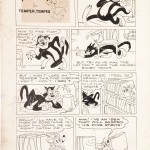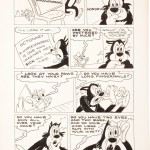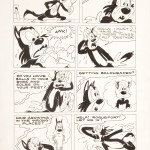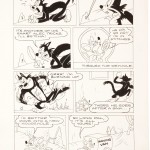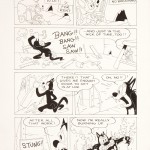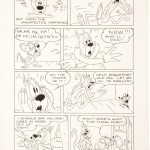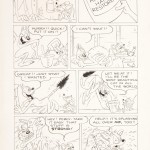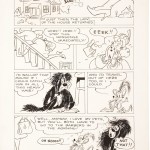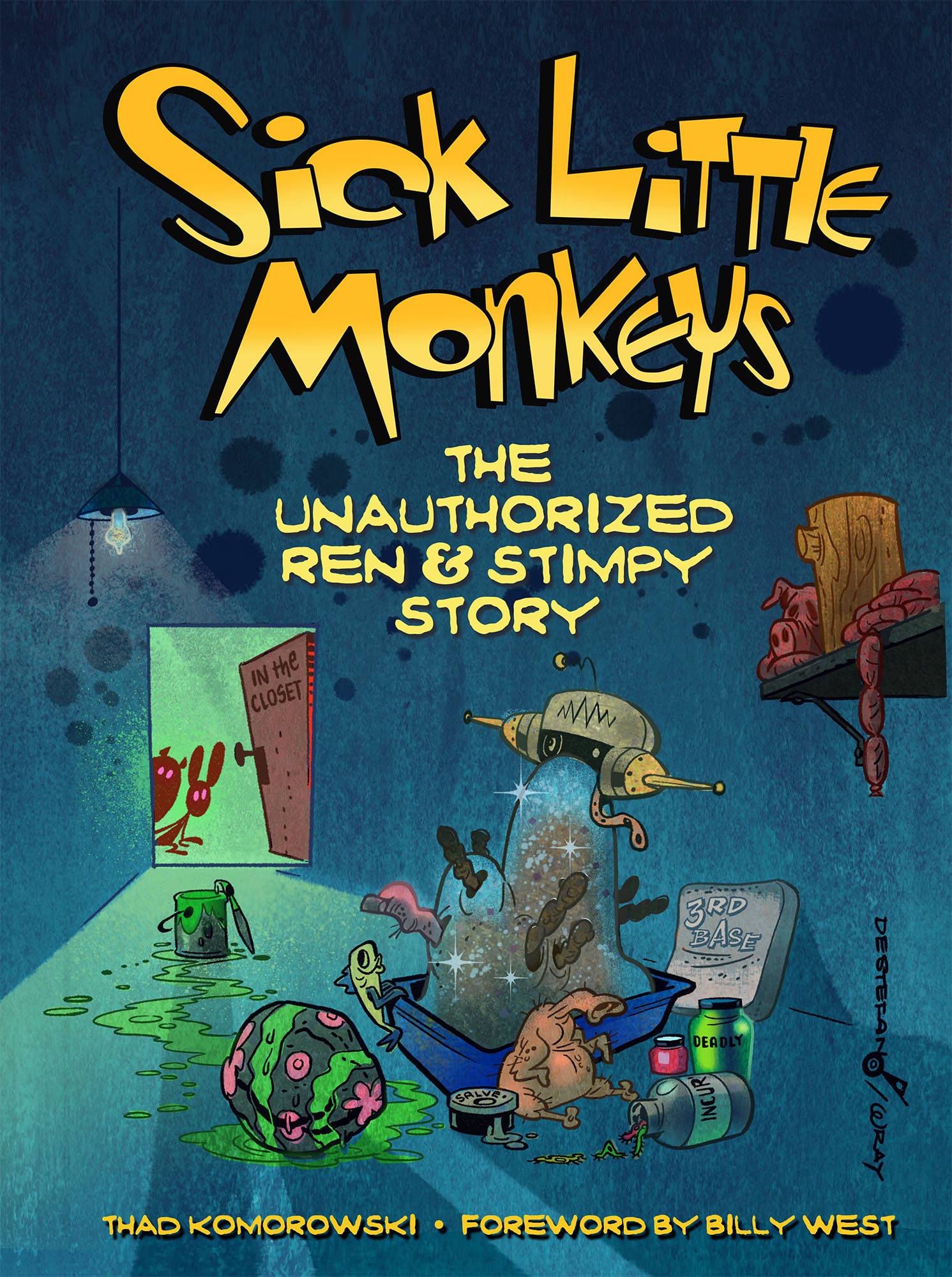The original art for this 8-page story drawn (and probably written) by Jim Tyer for Little Roquefort #7 was up for auction recently. I watched a pedigreed Tyerphile plan to snap it up, both of us thinking there was no way anyone would go after something like this. We were stupefied by the outrageous price paid for it, at least three times more than it was worth. Fortunately the pages were scanned at a very high resolution, so we can all enjoy this for the unbridled lunacy it is.
MGM Production # Update
Mike Barrier was kind enough to get back to me with the production numbers of MGM cartoons that were actually made that I was lacking, so the filmography is complete in that regard. Mike added this note about abandoned cartoons too:
Rudy Ising told me long ago that the “rejected” and “abandoned” labels shouldn’t be read suggesting that someone other than the director had rejected a cartoon. Those were just the numbers of stories that the directors scrapped before they got very far into work.
Thanks, Mike!
Filed under classic animation
Animator Breakdown: I Taw a Putty Tat
Another original titles discovery, nomn! Production #1072 is the excellent Friz Freleng cartoon I Taw a Putty Tat. For my money, this is probably the best of the Tweety & Sylvester series, although there would be many worthy contenders for that title throughout the years (Putty Tat Trouble, Ain’t She Tweet, Birds Anonymous, Hyde & Go Tweet). Freleng deserved his Oscar for instilling much needed personality into the two-character chase format, and this is a fine example of it at its most successful.
Just so this is not quite breaking from the barrage of Tashlin posts, some of the framework with the owner is lifted directly from Puss N’ Booty. Comparing that short with this one doesn’t accomplish a ton other than showing the differences in what satisfied each of the very different directors. The Tashlin cat-bird picture is a borderline cinematic masterpiece, whereas the Freleng shows how he perfected the art of directing meticulous and absolutely hilarious comedies. Every scene and gag works, right down to the frame. A great deal of this credit should go to Freleng’s right-hand man Hawley Pratt, one of Golden Age of Animation’s unsung greats whose amazing draftsmanship made so much of this happen.
There are some instances here and there in this short where it isn’t fine-tuned though. Tweety’s “Forgot my wittle hat again” is out of sync. Sylvester’s body isn’t properly shot after he inhales Tweety, and his lipsync is distractingly all over the place when he enters as a Swedish maid. I might attribute this to the fact that this one was rammed through the system as a Cinecolor short to help cash in on the popularity of the new comedy team after the Oscar win for Tweetie Pie. (Had it gone the ‘normal’ way in Technicolor, it wouldn’t have seen release until early 1949 at the latest.) Given how all of these directors were essentially well into working in an artistic vacuum at this point, it’s amazing how perfected they are most of the time.
Gerry Chiniquy is the star animator of this cartoon, animating the lion’s share of the footage. I’ve had reservations about his drawing style before (it’s pretty wiry, isn’t it?), but it’s the actual animation that counts, and he’s absolutely hilarious in the way he phrases his actions (in the 1940s anyway). The scene of Sly missing the first door only to be slammed by a second is a different kind of crazy than the Tashlin or Clampett kind. The cat goes through a ton of poses in a very short length of time, in a very limited kind of movement, but each of them reads properly.
The maid gag (Chiniquy again) may be one of the most underrated gags in cartoon history. While it proves once again Freleng had the best explosion timing of any director, some of the covert racism in the punchline is actually acceptable because the reference to his scorched flesh and passing out is the focus. Most other directors, including Tex Avery unfortunately, would have been satisfied with fading out after the results of the explosion, making the punchline that Sylvester sort of looks black.
Virgil Ross doesn’t get a ton to do in this cartoon, which is a shame. His drawings of Tweety are true things of beauty in the Warner art library, and there’s a real elegance to his approach in animating the characters. Ross makes a lot of what he’s doing easy when it’s really insanely difficult. When Tweety shoves the bulldog into the cage with Sylvester, he has the dog slowly scrunch up with Sylvester registering a look of horror, then machine guns to the next pose with the two face to face. You won’t find this kind of subtlety in many other cartoons, because it’s a kind of long-gone subtlety that doesn’t draw attention to itself.
Manny Perez gets away with a New York-patented popping effect that Bob Jaques writes about here. Rather than draw Tweety stepping away, Perez just makes him disappear completely, making the timing of Sly crushing his own foot even funnier. For what its worth, Ralph Bakshi always speaks highly of Manny Perez’s greatness whenever he talks about the old guard that regularly worked for him.
The uncredited Pete Burness scenes are a little awkward looking. The accenting of the poses is a little too elongated for the Freleng unit animation style, and his Tweety is between good off-model and bad off-model. The acting on Sylvester is fine, probably due to Burness’s experience animating Tom Cat for years.
I don’t have much to say about Ken Champin’s animation here. His scenes are well drawn and make the gags read as well as Freleng could hope for. Sylvester trying to stubbornly shove Tweety into his mouth could’ve been very easy to mush up, but it’s solid, man, solid.
There’s a large amount of tactful violence in Freleng’s cartoons in general. Sylvester suffers some fairly brutal treatment, but because the ridiculousness of the violence rather than the violence itself is emphasized. Not actually showing the carnage of the bulldog mauling Sly, but the hilarious covered, bouncing Chiniquy cage instead, is a completely Freleng touch. It’s too easy to imagine the same gags falling flat in a later Tom & Jerry or Famous Studios cartoon.
Another breakdown is coming up. It might have original titles too.
Filed under classic animation
‘Nother Tale of Two Mice
No further discourse on Tale of Two Mice itself for the time being, but here’s the cartoon that Tashlin remade it from, The Great Cheese Mystery. This was the last cartoon from the ‘old’ regime at Columbia, before Tashlin took over running things with The Fox and Grapes. Therefore it gets overshadowed by the greatness of that “Georgeous Technicolor” short, but it really shouldn’t.
The credited director is Art Davis, who would later become Tashlin’s most important animator at Warners, but it’s obviously Tashlin’s (the credited storyman – talk about role reversal!) baby more than anybody’s. Davis’ work at Columbia as a director is noticeably better than the others. Cartoons like Mr. Elephant Goes to Town and The Way of All Pests (which features a self-caricature of Davis) are only good by Columbia cartoon standards, given the studio’s output was an uninteresting landfill for much of its existence in the 1930s.
I have no idea how far Tashlin’s involvement went past the story stage for this cartoon. If I had to make an educated guess, it was a considerable lot, because the cutting, timing, and angular-looking animation and character designs (very atypical for a 1941 Columbia cartoon I must add) are all Tashlin earmarks. It easily holds its own against any of the best cartoons made at Warners at the time, a feat most studios weren’t able to accomplish without a former Warner guy heavily involved – usually by directing.
I also like this cartoon much more than the borderline-abhorrent The Tangle Angler that Tashlin was credited with directing later that same year. They were wise to make the sneezing dopey mouse silent. The choice makes it a much funnier cartoon, and it’s all too easy to imagine the obnoxious, generically directed Mel Blanc voice that he could have had, as in every other Columbia cartoon with a mouse released in ’41.
Comparing this short with Tale of Two Mice is a rare and fascinating glimpse of how far directors like Tashlin could evolve into better filmmakers in just a few short years. Hitchcock compared his two versions of The Man Who Knew Too Much saying, “The first was made by a talented amateur and the second was made by a professional.” There’s nothing amateurish about The Great Cheese Mystery but once you stack it against the 1945 Looney Tune, they do kind of seem lightyears apart when they were only made barely within four years of each other.
Filed under classic animation

